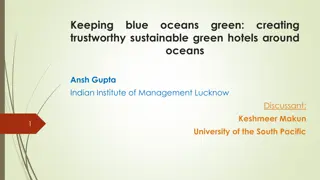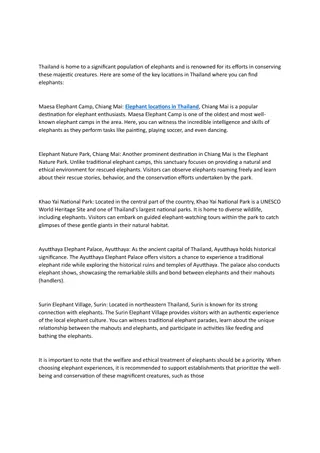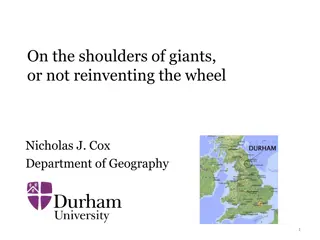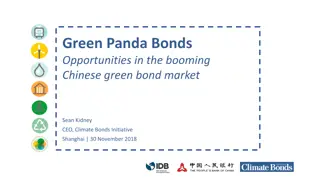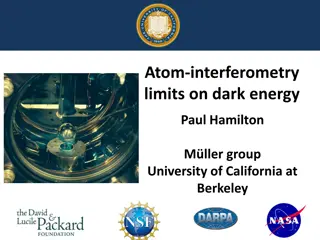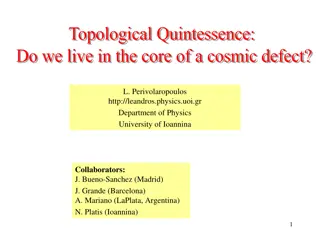THE DARK SHADOWS OF THE JOLLY GREEN GIANTS
In this presentation, Dr. Keith R. Skene explores the intersection of transportation and sustainability, tracing the historical evolution from wind-powered chariots to the first electric vehicles. The challenges of energizing transport systems are highlighted, emphasizing the need for cleaner alternatives like electric vehicles and hydrogen. The narrative delves into the impact of fossil fuels on global emissions and public health, prompting a reevaluation of traditional transportation methods. Through engaging visuals and insightful commentary, the audience is invited to reconsider the future of mobility and environmental conservation.
Download Presentation

Please find below an Image/Link to download the presentation.
The content on the website is provided AS IS for your information and personal use only. It may not be sold, licensed, or shared on other websites without obtaining consent from the author.If you encounter any issues during the download, it is possible that the publisher has removed the file from their server.
You are allowed to download the files provided on this website for personal or commercial use, subject to the condition that they are used lawfully. All files are the property of their respective owners.
The content on the website is provided AS IS for your information and personal use only. It may not be sold, licensed, or shared on other websites without obtaining consent from the author.
E N D
Presentation Transcript
THE DARK SHADOWS OF THE JOLLY GREEN GIANTS Week IIIa Dr Keith R. Skene BIOSPHERE RESEARCH INSTITUTE www.biosri.org
The challenge of energizing transport Societal function and structure have co-evolved with transportation Goods and people rely on it Supply chains are reliant upon it
Transport and fossil fuels Oil products account for 90% of total transportation fuel Transport accounts for 23% of world s carbon dioxide emissions In the EU, 500 000 premature deaths a year from aerial pollutants Yet motorized transport did not begin as an oil-based system.
Sailing chariots: wind-powered transport The Zeilwagen, designed by Simon Stevin, 1600
The first cars were electric vehicles 1828: Anyos Jedlik powered a small model car with a DC motor 1830: Joseph Henry proclaimed as inventor first DC electric motor 1832: Robert Anderson invented first single use battery vehicle 1834: Thomas Davenport invents first vehicle powered by a DC electric motor
Anyon Jedlik (1800-1895) Slovakian Did not report his work and so was not recognized as inventor of DC motor
Joseph Henry (1797-1878) Proclaimed as inventor of the first electric motor by coiling insulated copper wire around a magnet His work formed the basis of the first battery-operated vehicle.
Robert Anderson Around 1832 Used single-use batteries on a horse carriage
First gasoline car: Karl Benz 1886 And the rest, as they say, is history
1963 Ferrari 250 GTO: Auctioned for US$70 million
2015 Paris Agreement 100 million plug-in vehicles by 2030 This poses significant issues relating to supply chains, social impact and waste A study by Jiao and Evans (2016) identified current EV practices and market uptake barriers as unsustainable from economic, social, and environmental perspectives.
Cost issues The battery in an EV represents some 50% of the cost of the vehicle And only lasts for ten years Social justice issues arise, as punitive legislation to encourage shifts to EVs will impact the poor more than the rich, due to the barrier of cost This could impact on the ability to travel, especially in rural communities.
The tragedy of the Beeching Axe 5000 miles of track (one third of network) was lost A huge blow to public and freight transport
The Lithium battery Currently the sole technology due to high specific energy and power densities 57% of EVs have lithium-nickel-cobalt-manganese batteries 24% have lithium-iron-phosphate batteries LFP 16% have lithium-nickel-cobalt-aluminium batteries 4% have lithium-manganese oxide batteries (LMO)
The Lithium battery Currently the sole technology due to high specific energy and power densities 57% of EVs have lithium-nickel-cobalt-manganese batteries 24% have lithium-iron-phosphate batteries LFP 16% have lithium-nickel-cobalt-aluminium batteries 4% have lithium-manganese oxide batteries (LMO)
Key concerns Water availability: 2.25 million litres to extract 1 tonne of lithium leads to indigenous people and their livestock having to move Water contamination: waste water is pumped back into groundwater with hydrochloric acid High altitude, pristine, vulnerable ecosystems research needed urgently Poor indigenous people little or no compensation Vast appetite for lithium.
Supply issues If all cars globally (1 billion) used a lithium battery, supplies would begin to decline withing 5 years With a new battery needed every 10 years EV demand is forecast to require nearly all of the global lithium produced in 2030 even if supply increases at historic rates.
Alternatives? Mining lithium from the ocean floor Hugely detrimental to marine ecosystems and energy consuming Mining spodumene hugely damaging to environment Replacing with sodium battery? Issues with sodium supply
W. Liu et al. (2019) identified lithium mining activities as one of the major stressors leading to local environmental degradation.
Cobalt 73% of EV batteries rely on cobalt 64% of cobalt comes from the Democratic Republic of the Congo
Urgent need to switch to cobalt-free batteries This requires investment, research and immediate action Consumers must be informed of all supply chain issues Cobalt represents, perhaps, a darkest shadow of the joy green giant.
International Labour Organization report, 2017 Children were also exposed to the worst forms of child labour in the mines of Katanga and East Kasai, where around 40,000 children were working under the oversight of military units on mineral extraction. They worked in mines for up to 12 hours a day, for US$1 or $2, in extremely hot temperatures, without the slightest protection and in contact with high concentrations of cobalt. Completely unacceptable!




